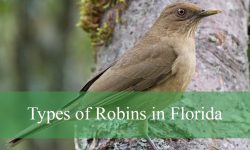Fascinating to observe are the wild rabbits of New Mexico, from the small and secretive cottontails to the swift, long-legged jackrabbits. Each species shows remarkable adaptations that allow it to survive in deserts, grasslands, and mountain slopes across the state. Spotting them in nature provides a deeper understanding of the balance within New Mexico’s ecosystems.
Cottontails, easily recognized by their rounded bodies and fluffy tails, often inhabit suburban edges, brushy fields, and desert scrublands. Jackrabbits, on the other hand, dominate the open plains with their impressive speed, keen eyesight, and ability to leap great distances when chased by predators. Together, these rabbits illustrate the diversity of the state’s wildlife.
This guide explores six types of wild rabbits that live in New Mexico, offering details on their identification, behaviors, habitats, and unique traits. From mountain foothills to desert valleys, these animals remain an essential part of the landscape and a delight to encounter.
Different Types of Wild Rabbits Found in New Mexico
Desert Cottontail (Sylvilagus audubonii)

The desert cottontail is a medium-sized rabbit that typically weighs between 2 to 3 pounds and measures around 14 to 17 inches in length. Its most distinctive feature is the large pair of ears, which help regulate body temperature in the hot, arid environments of New Mexico. The fur is usually grayish-tan or light brown with a paler underside, and the fluffy white tail gives the species its common name. Compared to jackrabbits, it has a shorter, more compact body and smaller legs, which makes it easy to identify.
Behaviorally, desert cottontails are crepuscular, meaning they are most active during dawn and dusk. During the heat of the day, they rest in shaded areas or burrows abandoned by other animals. When threatened, they often freeze in place to avoid detection, but if pursued, they escape in a quick zigzagging pattern that can reach speeds of up to 20 miles per hour. These evasive movements are crucial for avoiding predators such as coyotes, bobcats, hawks, and snakes.
Reproduction is an important aspect of their survival strategy. Breeding season generally runs from February through September in New Mexico, with females capable of producing several litters per year. Each litter can contain 2 to 6 young, called kits, which are born blind and hairless in nests lined with fur and vegetation. The rapid reproductive cycle helps maintain healthy populations despite heavy predation pressure.
Desert cottontails thrive in open, arid landscapes including deserts, grasslands, scrublands, and even suburban edges where cover is available. Their diet consists mainly of grasses, herbs, cacti pads, and shrubs, allowing them to survive in areas with scarce vegetation. A fun fact about this species is that it can survive long periods without direct water intake, obtaining much of its hydration from the plants it eats—an adaptation perfectly suited for New Mexico’s dry climate.
Eastern Cottontail (Sylvilagus floridanus)

The eastern cottontail is slightly larger and more robust than the desert cottontail, typically weighing between 2 to 4 pounds and measuring up to 18 inches in length. Its fur is reddish-brown on the back, with a lighter, whitish belly, and the trademark white tail is highly visible when the rabbit flees. The rounded body, shorter ears compared to desert cottontails, and rich chestnut tones in the fur are key identification features.
In terms of behavior, eastern cottontails are highly adaptable and are often seen in rural areas, farmlands, and even suburban neighborhoods. They are most active at dawn and dusk, preferring to forage under the cover of low light. Their primary defense strategy is remaining motionless in tall grasses or dense thickets until danger passes, and when startled, they can dart away in quick bursts, relying on their agility to escape predators.
Breeding season is long, often beginning as early as January and continuing through late summer. Females can produce three to four litters per year, with each litter averaging four to six kits. The young develop quickly, becoming independent within a month. This high reproductive rate is a key reason why eastern cottontails remain one of the most widespread rabbit species in North America.
In New Mexico, the eastern cottontail is found more frequently in the eastern and southern regions of the state, especially in areas where woodlands meet open fields. They feed on grasses, clover, bark, twigs, and cultivated plants, which sometimes brings them into conflict with gardeners. A fun fact about this rabbit is that it has excellent vision and hearing, allowing it to detect predators from a distance—even though its eyes are positioned on the sides of its head.
Mountain Cottontail (Sylvilagus nuttallii)
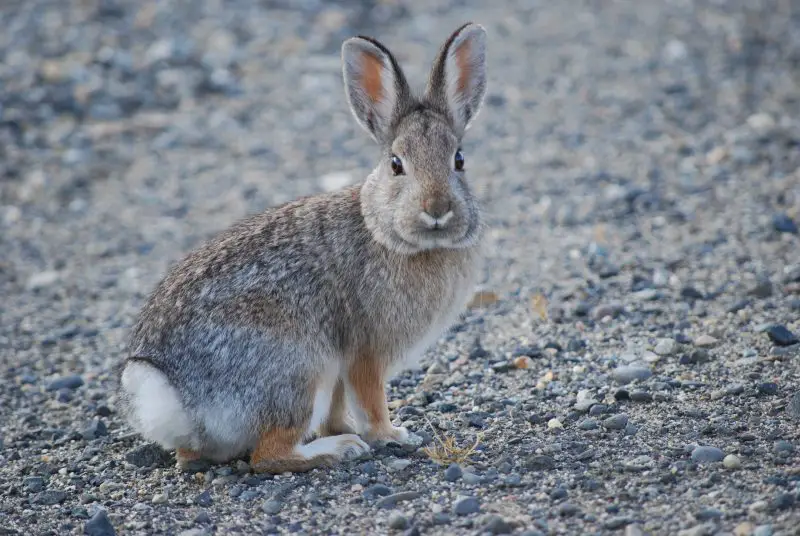
The mountain cottontail is a smaller, compact species that usually weighs between 1.5 to 2.5 pounds and measures around 13 to 15 inches long. Its fur is grayish-brown with a mix of black-tipped hairs, giving it a slightly mottled appearance that blends well with rocky and shrubby environments. The ears are shorter than those of other cottontails, and the white underside of the tail is still noticeable, though less prominent than in desert or eastern cottontails.
This rabbit’s behavior reflects its adaptation to higher elevations. It prefers cooler climates and is active in the early morning and late evening. When threatened, mountain cottontails usually hide in dense shrubs or rock crevices rather than relying solely on running. They can still sprint rapidly in short bursts, but their reliance on natural cover helps them survive in rugged environments where predators such as raptors, foxes, and coyotes are common.
Reproduction follows a seasonal cycle, with breeding occurring mainly in spring and early summer. Females can have multiple litters per year, with each litter averaging three to five kits. Like other cottontails, the young are born blind and helpless but grow quickly. By three weeks of age, they begin leaving the nest to forage independently, ensuring the population remains stable even in areas with high predation.
Mountain cottontails in New Mexico are mostly found in the foothills, canyons, and mountainous regions of the northern and central parts of the state. They feed on grasses, sagebrush, and woody plants, shifting their diet to bark and twigs during the winter months. A fun fact about this species is that it has been observed climbing onto low shrubs or rocks to reach food, a behavior not commonly seen in other cottontails.
Black-tailed Jackrabbit (Lepus californicus)
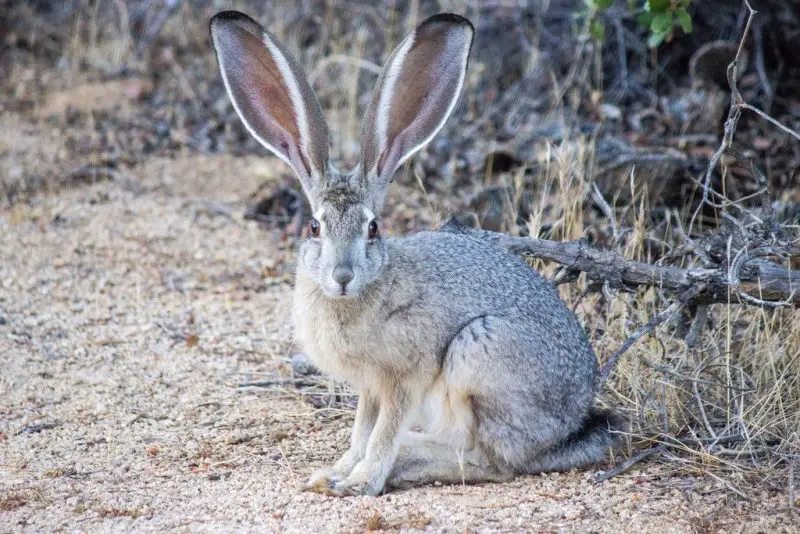
The black-tailed jackrabbit is one of the most iconic wild rabbits of New Mexico, known for its long ears and powerful legs. Unlike cottontails, jackrabbits are hares and are much larger, often weighing between 3 to 6 pounds and measuring up to 24 inches in length. Their fur is generally a mix of gray and brown with a distinctive black stripe running down the top of the tail, which is how they got their name. The extremely long ears are not only useful for detecting predators but also serve as natural cooling systems in the desert heat.
Behaviorally, black-tailed jackrabbits are highly alert and rely on their speed and stamina to escape threats. They can run at speeds of up to 40 miles per hour and cover long distances in powerful leaps. During the day, they often rest in shallow depressions in the ground, called forms, instead of digging burrows like cottontails. They are primarily nocturnal, venturing out at night to forage while avoiding the intense desert sun.
Their diet consists mostly of grasses, forbs, shrubs, and cacti. Black-tailed jackrabbits have adapted to survive in extremely dry environments by extracting moisture from the plants they consume, much like desert cottontails. Breeding season runs nearly year-round in New Mexico, and females may have three to four litters per year, each containing one to six leverets (young hares). Unlike cottontail kits, leverets are born fully furred and with their eyes open, able to move soon after birth.
In New Mexico, black-tailed jackrabbits are widespread, thriving in deserts, grasslands, and scrublands across much of the state. They are especially common in open areas with sparse vegetation, where they can spot predators from a distance. A fun fact about this species is that they play an important ecological role by serving as prey for coyotes, hawks, and golden eagles, making them a key link in the desert food chain.
White-tailed Jackrabbit (Lepus townsendii)
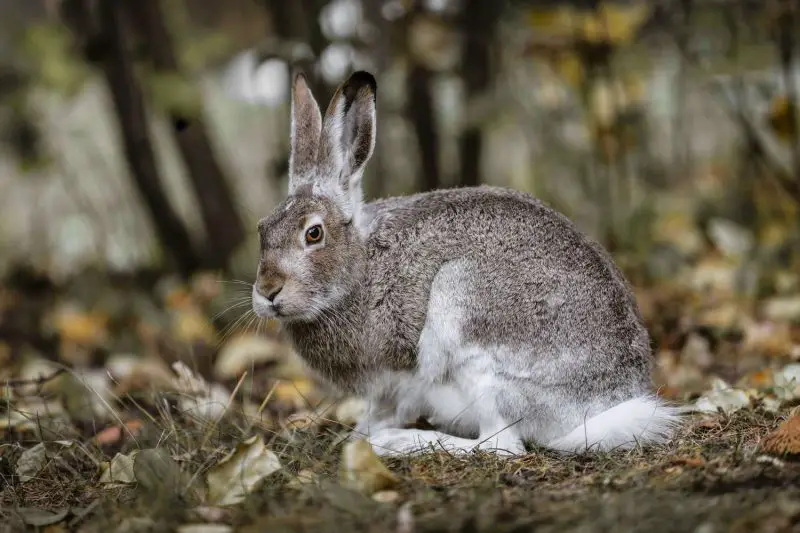
The white-tailed jackrabbit is the largest hare in North America and can reach up to 24 inches in length and weigh as much as 6 to 10 pounds. It has long legs and tall ears, though slightly shorter than those of the black-tailed jackrabbit. The fur is grayish-brown in summer but turns almost completely white in winter, providing excellent camouflage against snow. Its namesake feature is the large, bright white tail that contrasts sharply when it bounds away.
This species is more solitary than cottontails and tends to inhabit open grasslands, meadows, and higher elevation prairies. White-tailed jackrabbits are crepuscular and nocturnal, foraging mainly at night and early morning. They rely on their impressive speed and powerful leaps to evade predators, often bounding in long, dramatic arcs across open terrain. When threatened, they may sit motionless until the last second before exploding into a sprint.
Their diet shifts with the seasons, consisting of grasses and herbs in summer and woody vegetation such as twigs and bark in winter. Breeding season occurs from early spring into midsummer, with females producing one to three litters per year. Each litter typically has one to six leverets, which, like other hares, are born with fur and open eyes, allowing them to be mobile shortly after birth.
In New Mexico, the white-tailed jackrabbit is less common than the black-tailed jackrabbit and is mostly found in the northern parts of the state, especially in grasslands and foothills at higher elevations. A fun fact about this species is that its seasonal coat change is a rare trait among hares living in the U.S., allowing it to blend seamlessly into snowy winter landscapes.
Antelope Jackrabbit (Lepus alleni)
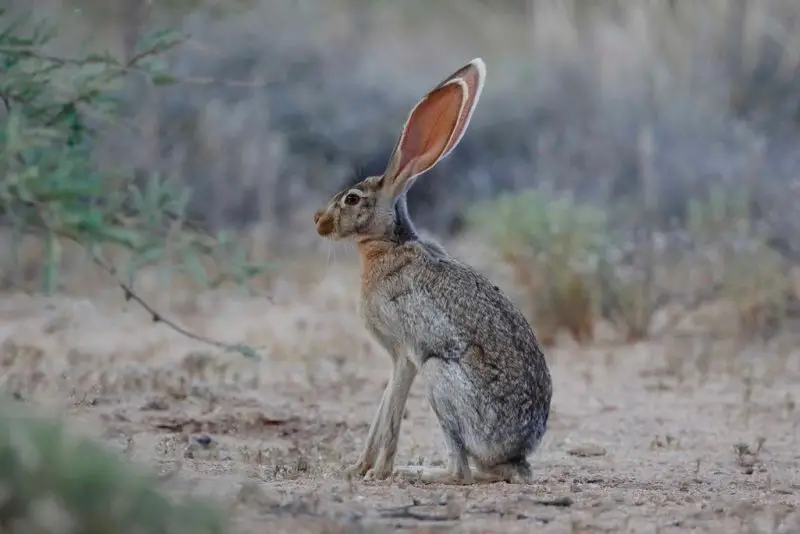
The antelope jackrabbit is a striking species, easily recognized by its enormous size and long ears that can reach up to 8 inches in length. Adults typically measure 18 to 24 inches and can weigh between 5 to 9 pounds, making them one of the largest hares in North America. Their fur is silvery-gray with a white underside and flanks, and they have a distinctive orange-colored patch on the sides of the neck. The tail is black on top and white underneath, which flashes as they run.
This jackrabbit is named after the pronghorn antelope because of its running behavior. When startled, it often leaps several feet into the air and runs in fast, bounding strides that resemble those of an antelope. Antelope jackrabbits are more diurnal than other hares, sometimes active during the day as well as at dusk and dawn. They are incredibly alert animals, relying on keen eyesight, hearing, and speed to avoid predators.
Their diet is mainly composed of grasses, mesquite, shrubs, and cacti. Like other desert-dwelling rabbits, they can survive long periods without free-standing water by obtaining moisture from their food. Breeding occurs from January through September, and females may have several litters per year with one to five leverets each. The young are born well-developed and quickly capable of moving on their own.
In New Mexico, antelope jackrabbits are found primarily in the southern desert regions near the Mexican border, where open grasslands and thornscrub habitats dominate. A fun fact about this species is that it can leap up to 20 feet in a single bound, making it one of the most athletic rabbits in North America. This spectacular leaping ability helps confuse predators and provides a remarkable sight for those lucky enough to witness it.
Best Times and Places to Observe Wild Rabbits in New Mexico
Wild rabbits and jackrabbits are active throughout New Mexico, but the best times to see them are during the early morning hours just after sunrise and in the evening before sunset. These crepuscular periods allow them to feed in safety while avoiding the harsh desert heat and daytime predators. On cooler days or during overcast weather, you may also spot them foraging in the open during daylight.
For those looking to observe cottontails, suburban edges, agricultural fields, and desert scrublands are great places to start. Desert cottontails are widespread and easily seen across much of the state, while eastern cottontails prefer brushy areas and farmland in the east and south. Mountain cottontails are more likely to be found at higher elevations in foothills, canyons, and rocky mountain slopes.
Jackrabbits, on the other hand, are best spotted in wide-open areas where their speed and leaping ability are most effective against predators. Black-tailed jackrabbits are common in deserts and grasslands, white-tailed jackrabbits inhabit northern grasslands and higher plains, while antelope jackrabbits are concentrated in the southern desert near the Mexican border. Open roadsides, desert highways at dawn, and quiet hiking trails often provide the best chances to see them in the wild.
FAQs about Wild Rabbits in New Mexico
What is the difference between cottontails and jackrabbits in New Mexico?
Cottontails are smaller, with rounded bodies and short legs, and they often hide in vegetation when threatened. Jackrabbits are hares, much larger in size, with long legs and ears, and they rely on speed and leaping to escape predators.
Are wild rabbits in New Mexico active during the day?
They are most active during dawn and dusk. On cooler or cloudy days, cottontails and jackrabbits may forage during daylight, but they typically rest in shaded areas during the hottest hours.
What do wild rabbits eat in New Mexico?
Their diet varies by species and season. Cottontails eat grasses, herbs, and shrubs, while jackrabbits feed on grasses, forbs, cacti, and woody plants. In winter, both may shift to bark and twigs when green plants are scarce.
Where can I see jackrabbits in New Mexico?
Black-tailed jackrabbits are widespread in deserts and grasslands, white-tailed jackrabbits prefer higher plains in the north, and antelope jackrabbits are found mainly in the southern deserts near the Mexico border.
Do wild rabbits play an important role in New Mexico’s ecosystem?
Yes. They are a critical food source for predators such as coyotes, hawks, eagles, and bobcats. By feeding on plants, they also help shape vegetation communities in deserts, grasslands, and mountains.


